#jacamar
Text
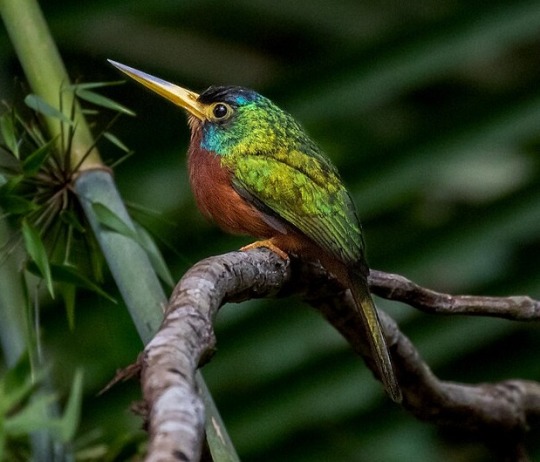
Blue-cheeked Jacamar (Galbula cyanicollis), male, family Galbulidae, Brazil
photograph by Hector Bottai
1K notes
·
View notes
Text
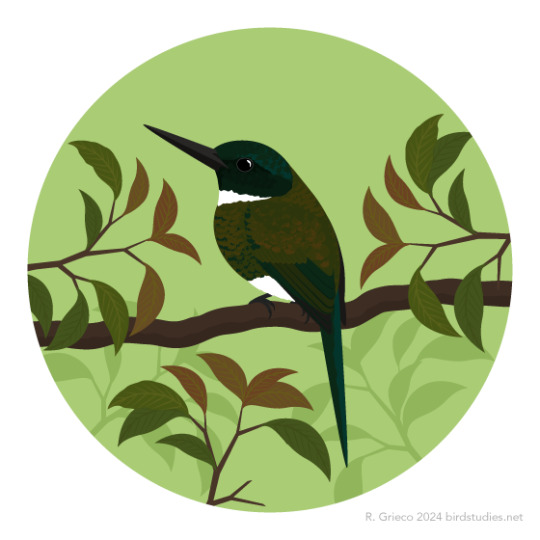
March 5, 2024 - Bronzy Jacamar (Galbula leucogastra)
Found in parts of Bolivia, Brazil, Colombia, French Guiana, Guyana, Suriname, and Venezuela, these jacamars live in forests, savannas, shrublands, and wetlands. Foraging alone, in pairs, or in groups of up to four, they feed on flying insects, capturing prey in short flights from perches and occasionally joining mixed-species flocks. Only three of their nests have been described, two in arboreal termite nests and one in a bromeliad on a large tree trunk. Both parents fed the chicks at the first two nests though only the female fed them at the third.
84 notes
·
View notes
Text
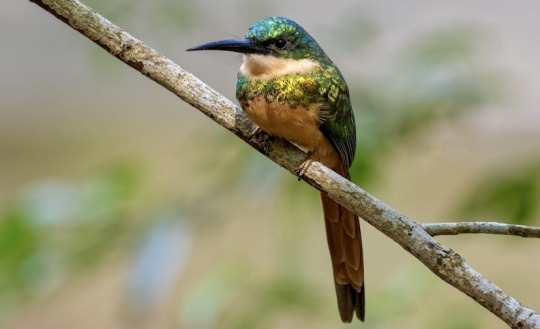

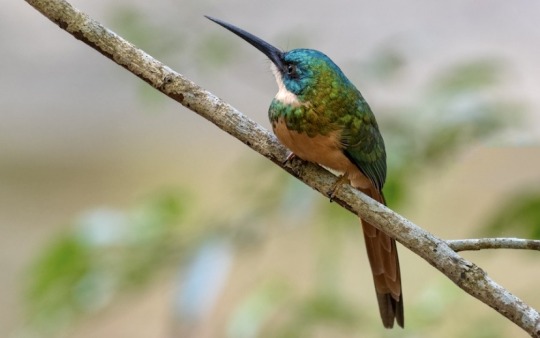

the rufous-tailed jacamar is a small, brightly colored bird found in south america. this insectivorous species is often found hunting insects in tropical forest habitats. males of the species are differentiated by their bright white throat. eggs are laid either in a shallow burrow or a termite nest, which may double as a repellent for mites. members of the species are able to differentiate between butterfly species based on shape. although they are known to resemble both hummingbirds and kingfishers, they are more closely related to woodpeckers.
708 notes
·
View notes
Note
Trick or Treat! :D
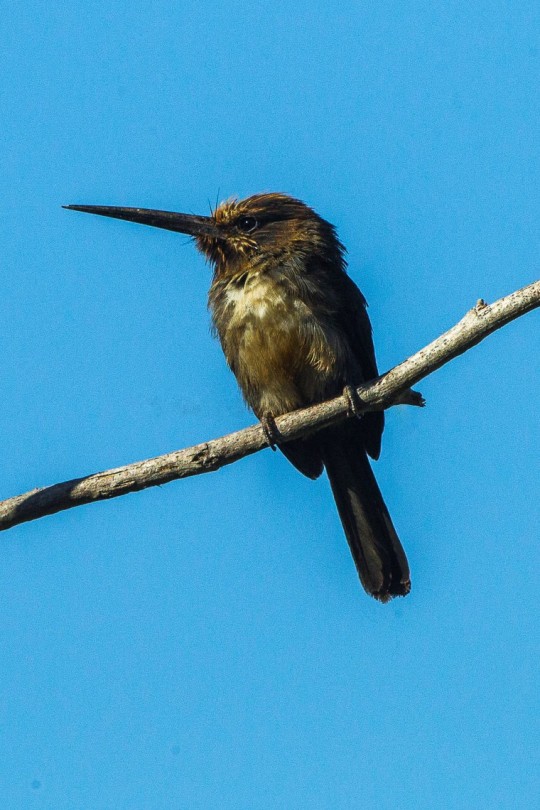
Three-Toed Jacamar!
Please do not send me more trick or treat asks, I am only answering the ones I could not get to after I hit post limit last night, it is Nov 1st we have other shenanigans to attend to!
22 notes
·
View notes
Text
BOTD: Rufous-tailed Jacamar

Photo: Egon Fink
"Handsome, slender, green-and-rusty bird of humid tropical lowlands. Lives in evergreen forest, often at edges and around adjacent clearings. Perches upright at mid-heights on vines or other exposed perches and sallies out for flying insects, especially butterflies, dragonflies, and wasps. Note the very long, slender black bill (like a giant hummingbird). Throat is white on male and buffy on female. Loud shrieking calls may draw attention."
- eBird
#birds#rufous tailed jacamar#birds of north america#north american birds#jacamar#jacamars#birds of mexico#birds of central america#birds of america#american birds#bird#birding#birdblr#birblr#bird watching#bird of the day#Galbula ruficauda
37 notes
·
View notes
Photo
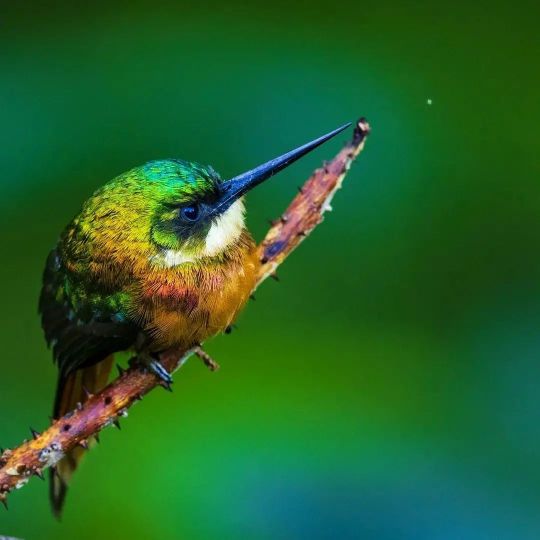
Rufous-tailed Jacamar
13 notes
·
View notes
Photo
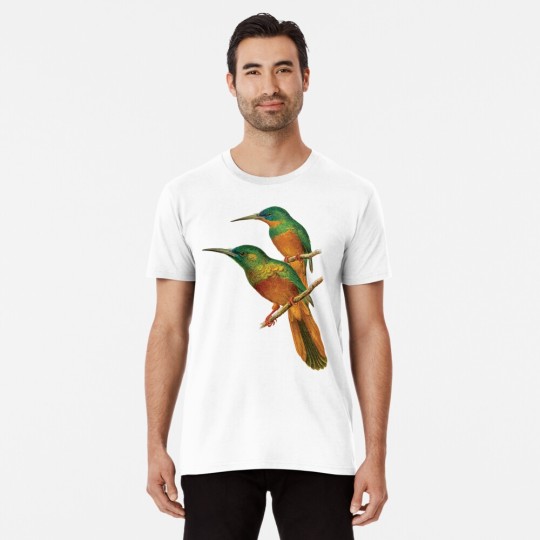
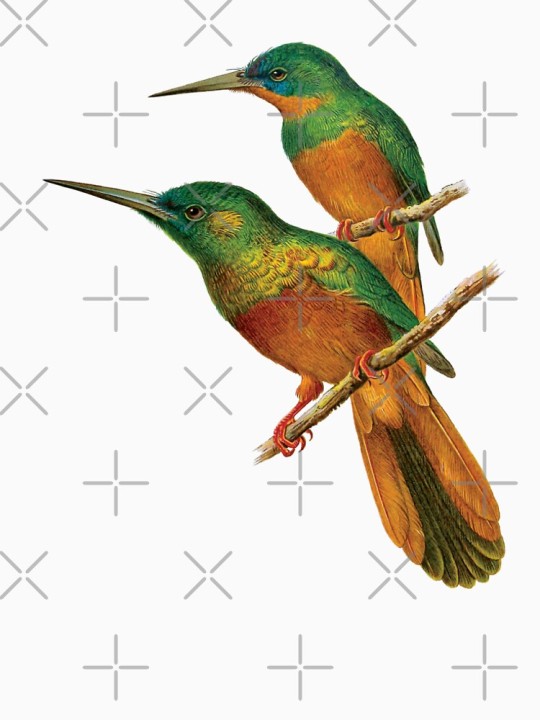
(via The colorful bird Coppery-chested Jacamar (Galbula pastazae). Premium T-Shirt by Luggnagg)
#findyourthing#redbubble#tropica birds#birdlovers#bird lover#bird lovers#tropical#exotic birds#ornithology#ornithologist#jacamar#tropical birds
1 note
·
View note
Text

[2687/11080] Coppery-chested jacamar - Galbula pastazae
Order: Piciformes
Suborder: Galbuli
Family: Galbulidae (jacamars)
Photo credit: Diana López G via Macaulay Library
169 notes
·
View notes
Text
Fossil Novembirb: Day 13
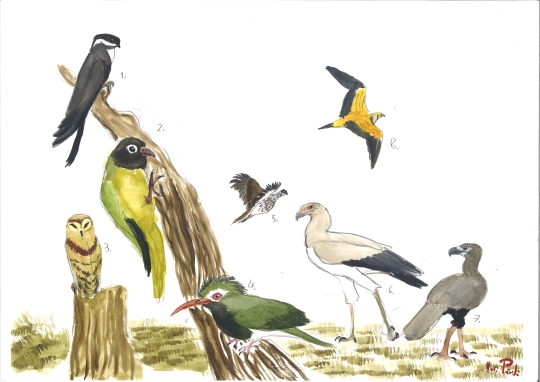
The phosphorate beds of Quercy, France preserve a wealth of fossils from the late Eocene and Oligocene epoch, about 35-25 million years ago. At that time, the early Paleogene jungle hothouse had ended. The climate was drying and cooling, and in parts of the world forests were giving way to savannah and scrubland, as was in Quercy. But that didn't stop birds. They started to take advantage of these new wide open spaces.
Aegialornis: An enigmatic bird that was closely related to swifts. Unlike swifts, it could perch and hold on to branches, but it was also an incredible flyer.
Quercypsitta: A unique group of not well known stem-parrots which likely resembled the earlier Halcyornithids, corvid-like stem-parrots from Europe and North America.
Palaeoglaux: Also known from the Messel Pit, this early relatively small owl may have been a diurnal hunter of small prey and had peculiar body feathers.
Sylphornis: A mysterious member of the piciformes with unique morphology, resembling jacamars and puffbirds.
Paraortyx: One of the earliest true phasianid galliforms, related to partridges, pheasants and chickens. It likely had a similar lifestyle to them, only taking flight when necessary.
Pelargopappus: An early relative of the long-legged secretarybird, this Eocene relative stalked the plains in a similar manner, stomping down on any prey it could catch.
Strigogyps: An omnivorous turkey-sized member of the cariamiform family, it is also known from the middle Eocene of Germany.
Archaeoganga: A relatively large and one of the earliest members of that wonderful desert bird clade, the sandgrouse.
#Fossil Novembirb#Novembirb#Dinovember#birblr#palaeoblr#Birds#Dinosaurs#Cenozoic Birds#Aegialornis#Quercypsitta#Palaeoglaux#Sylphornis#Paraortyx#Pelargopappus#Strigogyps#Archaeoganga
37 notes
·
View notes
Note
welp. So that you may have Something Not Mean in the chaos have a rufous tailed jacamar! They’re a neat looking bird with a fun call, it’s a high pitched buzzy trill. May people as a whole someday come to a better mode of conflict resolution than *insert site* vaguing and ask box harassment

thank you i love him
eh, it happens. they have the right to be annoyed bc i was yapping but i also do have the right to feel offended so, yeag
5 notes
·
View notes
Note
Hello! Do you have daemon form suggestions for an ISTJ 3w4 (tritype 315 or 316). Thank you in advance and don't feel rushed!
oh absolutely! i love ISTJ 3s, they're very driven and ambitious.
i wonder if a kingfisher would be a good place to start for you? i've suggested the belted kingfisher would be a good form for an ISTJ 3 in the past and i stand by it — they're observant and driven, confident and proud of their space, opinionated and communicative, as well as fairly specialized and experts in their field. i feel like this goes along well with the ISTJ 3's SiTe and sense of responsibility/drive to succeed. the ringed kingfisher is also an option, as they're going to be more even-tempered and enduring than the belted kingfisher. the amazon kingfisher is also similar to the belted kingfisher, but again more even-tempered and reserved.
other coraciiformes are always good suggestions for the xxTJ 3, though many of them are more fitting for an extrovert. there are some more solitary species, however, such as the previously mentioned kingfishers and motmots. motmots are very much enneagram 3. expressive, bold, and willing show-offs, these birds would fit someone who's selectively social and image-oriented. but they also put their money where their mouth is. they're driven, hard-working, and willing to be cooperative to meet their goals. they tend to be very alert, opportunistic, and judgmental.
there are also lots of birds of prey that really fit an ISTJ 315! to just throw out a few, the red-tailed hawk, red-backed hawk, or galapagos hawk seem like really strong fits. all of those hawk species are bold, confident, and adaptable yet also cliquish and committed; i would expect them to be socially selective people who have high standards for themselves and others. the red-tailed hawk is more independent, assertive and challenging, and likely more stubborn as well. the red-backed (also called variable) hawk is highly adaptable, determined, and calculating, fairly similar to the red-tailed but just a touch less bold. the galapagos hawk really stands apart as the most socially tolerant, cooperative, and loyal one of the group. those aside, hawk-eagles might also be a good option as they're pretty similar. on average they're specialized, confident, opportunistic, committed, and ambitious. they'd prefer to see a project through for the sake of their pride rather than adapt to circumstances, and they definitely can be expressive in a show-off sort of way. and finally the bateleur is also a magnificent form i think would fit you. very confident and showy as well, intense and loyal, judgmental and competitive. not high strung at all and comes across as cocky, stubborn, and effortlessly adaptable.
i wanted to mention piciformes specifically, as i think they really encompass both the drive of the ISTJ and the image-seeking aspects of the enneagram 3. they're all going to be relatively introverted and ambitious; jacamars, honeyguides, and woodpeckers i think are the best fitting. jacamars are relatively patient, opportunistic, and driven, very expressive and communicative so long as they're in their comfort zone. they're more socially-inclined than most of these species which might be a dealbreaker for you, as they most of them are quite cooperative and derive a sense of confidence from having others around. honeyguides are more loosely loyal and introverted, more competitive and opportunistic while not being so ambitious. they tend to be quite intense and shrewd and they follow their whims. as brood parasites, they have a reputation for being manipulative and "work smarter not harder" types of people. they're quite expressive, but not very adventurous and are more sensitive than they let on. finally woodpeckers are hard-working and assertive, definitely willing to be stubborn and possessive if someone tries to change their course. they're highly persistent, driven, and organized, preferring to plan ahead rather than be spontaneous. some species are more socially gregarious and cooperative, but a more introverted type like the downy woodpecker seems like a potential option, or the red-bellied woodpecker or red-breasted sapsucker.
if you're not feeling birds at all, check out arvicola, the water voles. they're going to be less bold more anxious/sensitive than the above forms. this fear of failing or not achieving drives their hard-working nature, and they tend to be very proud of what they've accomplished. they're planners rather than spontaneous but tend to be inventive within their comfort zone. they're also socially flexible; while they tend to prefer to work alone, they don't like rocking the boat and can be more bark than bite.
hope this helps!
6 notes
·
View notes
Text
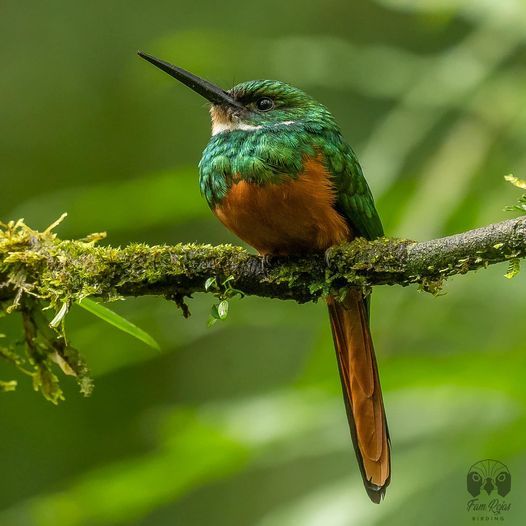
Rufous-tailed Jacamar (Galbula ruficauda), male, family Galbulidae, order Piciformes, Costa Rica
Photograph by Luis Ricardo Rojas
392 notes
·
View notes
Text

September 21, 2023 - Three-toed Jacamar (Jacamaralcyon tridactyla)
These jacamars are found in southeastern Brazil in forests, often near streams and roads. They eat insects, hunting in short flights from perches in groups of two to ten. Breeding from September to February, they may nest in colonies and breed cooperatively. They excavate nest burrows in banks, often building several at the same time. Pairs incubate clutches of two eggs, possibly with assistance from other adults. Classified as Near Threatened by the IUCN, their population is likely declining due to deforestation.
59 notes
·
View notes
Photo

🔥 Rufous tailed jacamar
1 note
·
View note
Photo

. Nome Popular: Ariramba-de-cauda-ruiva English Name: Rufous-tailed Jacamar Família / Family: Galbulidae Nome Científico: Galbula ruficauda Uma ave inquieta quando está concentrada em sua refeição. O bote é certeiro, dificilmente o inseto escapa do seu ataque... Mede entre 19 e 24 centímetros e pesa entre 18 a 28 gramas. Muitas pessoas acham que se trata de um grande beija-flor, devido ao seu bico longo e fino, quanto à coloração verde-amarelada iridescente de grande parte da plumagem. No macho as partes superiores, incluindo a face, a coroa e o peito são de coloração verde brilhante metálico. As garras são negras. A garganta é branca, enquanto na fêmea e nos machos juvenis ela é ferrugínea. Nas fêmeas, o abdômen é castanho, ligeiramente mais pálido do que o macho. Caça exclusivamente insetos em voo, com uma habilidade enorme e velocidade para apanhar presas. Após capturar o inseto, volta ao ponto de partida e bate-o repetidamente contra o galho, retirando asas e quebrando a carapaça externa, o que facilita a ingestão. Cava galerias estreitas e compridas nas barrancas de rios, em cupinzeiros nas árvores ou nos torrões de terra presos nas raízes de grandes árvores tombadas. Vive em casais o ano inteiro, com os filhotes sendo alimentados pelos pais por algumas semanas após saírem dos ninhos. Macho e fêmea chocam até quatro ovos por ninhada. . . . . . . . . . #aves #avesbrazil #beautiful #bestbirdshots #bestnatureshots #bird #birdlovers #birdphotography #birds #birdsofinstagram #birdwatching #brasil #brazil #canon #canonphotography #cute #exclusive_wildlife #instagood #instagram #love #natgeo #natgeoyourshot #nature #nature_perfection #naturephotography #wikiaves #terradagente #world #parquenacionaldasemas #matogrosso (em Parque Nacional das Emas) https://www.instagram.com/p/CjglAF5r81I/?igshid=NGJjMDIxMWI=
#aves#avesbrazil#beautiful#bestbirdshots#bestnatureshots#bird#birdlovers#birdphotography#birds#birdsofinstagram#birdwatching#brasil#brazil#canon#canonphotography#cute#exclusive_wildlife#instagood#instagram#love#natgeo#natgeoyourshot#nature#nature_perfection#naturephotography#wikiaves#terradagente#world#parquenacionaldasemas#matogrosso
0 notes
Photo
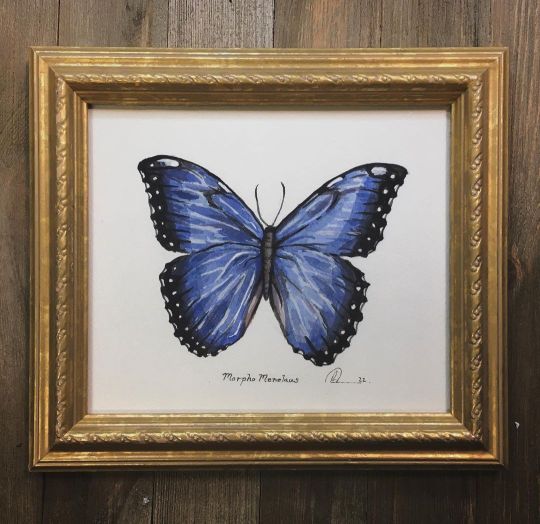
The Menelaus blue morpho is one of thirty species of butterfly in the subfamily Morphinae. Its wingspan is approximately 12 cm, and its dorsal forewings and hindwings are a bright, iridescent blue edged with black. While the butterfly has a beautiful blue coloring, it doesn't actually have any pigment to make it look that way. In fact, the blue morpho uses structural color to get its particular shade of blue. Blue is actually an extremely rare color in nature. Blue morphos are severely threatened by deforestation of tropical forests and habitat fragmentation. Humans provide a direct threat to this spectacular creature because their beauty attracts artists and collectors from all over the globe who wish to capture and display them. Aside from humans, birds like the jacamar and flycatcher are the adult butterfly’s natural predators. https://etsy.me/2wrjMur . . . #menelausbluemorpho #bluemorpho #morpho #morphobutterfly #butterfly #moths #mothsandbutterflies #butterfliesofinstagram #butterflies🦋 #natureillustration #illustration #watercolor #painting #etsyshop #handmade #supportartists #artistsoninstagram #forsalebyartist #arizonaartist #tucsonartist #tucsonillustrator (at Tucson, Arizona) https://www.instagram.com/p/CgnsiNxLFDh/?igshid=NGJjMDIxMWI=
#menelausbluemorpho#bluemorpho#morpho#morphobutterfly#butterfly#moths#mothsandbutterflies#butterfliesofinstagram#butterflies🦋#natureillustration#illustration#watercolor#painting#etsyshop#handmade#supportartists#artistsoninstagram#forsalebyartist#arizonaartist#tucsonartist#tucsonillustrator
0 notes